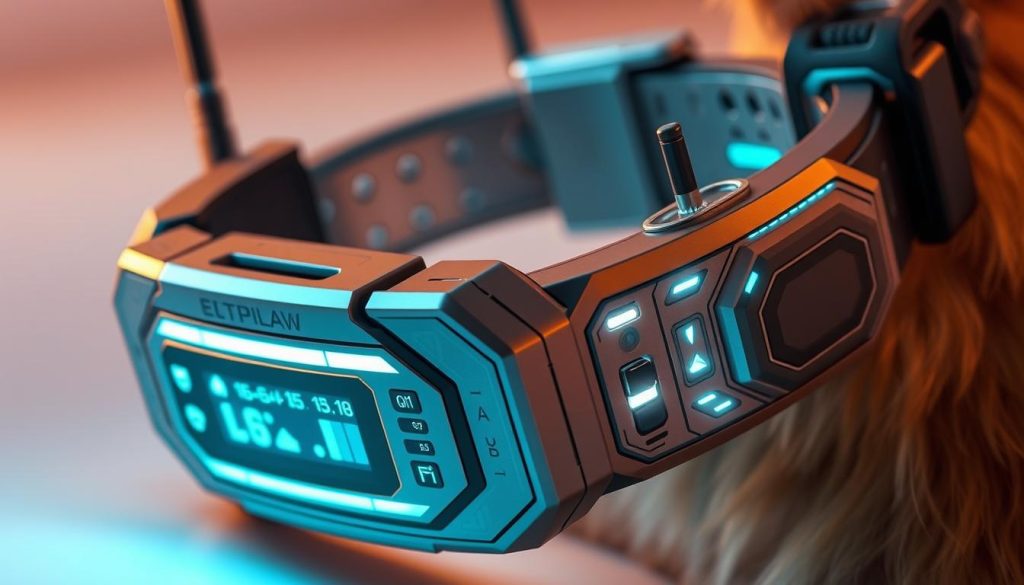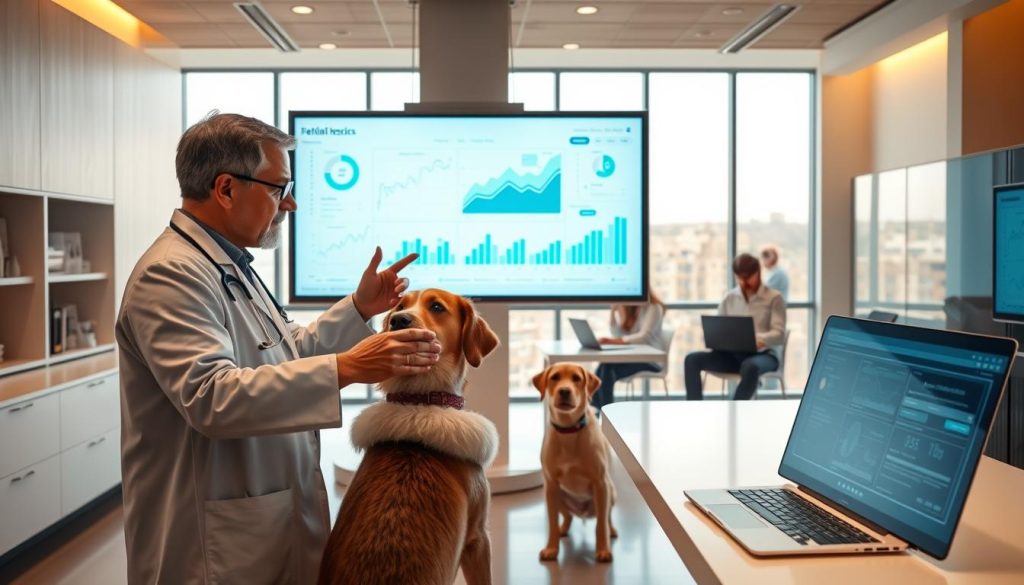Technology is reshaping how we care for our furry companions. Gone are the days when collars served only as ID tags. Today’s devices track heart rates, sleep patterns, and even stress levels, offering real-time insights into animal well-being. This shift reflects a broader trend: owners now prioritize preventive measures over reactive treatments.
Modern innovations combine sensors, cloud computing, and machine learning to spot health issues early. For example, unusual activity drops or changes in eating habits can trigger alerts before symptoms become visible. With over 470 million dogs globally, demand for these tools is surging—experts predict a 20% market growth in wearable tech for animals within five years.
Families increasingly view their four-legged members as equals, driving interest in advanced care solutions. Veterinarians also benefit, using data from collars to create tailored treatment plans. This collaboration between tech and medicine helps catch problems faster, reducing emergency visits and long-term costs.
Key Takeaways
- Advanced collars now monitor vital signs and behavior patterns 24/7
- Global demand for animal wearables could grow 20% by 2028
- Early detection systems help prevent serious health complications
- Data sharing improves vet visits through personalized insights
- Real-time tracking reduces risks during outdoor activities
Technology Trends Shaping Modern Pet Health
Modern solutions are enhancing the way we ensure animal wellness. Wearable gadgets now go beyond basic tracking, offering detailed health insights through advanced sensors. These tools help families stay proactive about their companions’ needs.
Emerging IoT Devices and Wearable Sensors
Connected gadgets collect real-time data through tiny sensors. Collars and vests track heart rhythms, body heat, and movement patterns. GPS tags add location safety, while accelerometers detect unusual restlessness.
| Device Type | Sensors | Key Function |
|---|---|---|
| Smart Collars | Heart rate, temperature | Activity monitoring |
| Tracking Vests | Motion detectors, GPS | Location alerts |
| Health Tags | Accelerometers, microphones | Behavior analysis |
Mobile apps sync with these devices, showing trends over time. Sudden changes trigger instant notifications to owners and clinics. This constant watch helps catch issues like overheating or irregular heartbeats early.
Integration of Artificial Intelligence in Veterinary Diagnostics
Machine learning systems analyze medical scans with surprising precision. They spot bone fractures in x-rays 40% faster than human experts. Some algorithms even detect subtle tumors that escape manual review.
These AI tools cross-check symptoms against vast databases. Vets get detailed reports highlighting possible concerns. “The speed and accuracy help us act before conditions worsen,” notes a Boston clinic director.
Combined with wearable data, these technologies create complete health profiles. Early warnings mean simpler treatments and happier animals. It’s a win for busy families and care providers alike.
AI-Powered Pet Health: Smart Collars and Predictive Veterinary Care

Today’s animal companions benefit from technology once reserved for humans. Modern neckwear devices now include sensors that rival hospital-grade equipment, tracking everything from hydration levels to REM sleep cycles.
Cutting-Edge Smart Collar Features
These devices pack powerful tools into compact designs. Key capabilities include:
- Continuous heart rhythm tracking to spot irregularities
- Water intake measurements through motion analysis
- Sleep quality scoring based on movement and breathing
- Two-way audio for comfort during separation
One golden retriever owner credits their device for catching a 20% drop in daily activity. This led to an early arthritis diagnosis. “We adjusted exercise routines before limping began,” they shared.
Predictive Analytics for Early Health Interventions
Machine learning transforms raw numbers into actionable alerts. Systems compare current patterns against months of historical information. Sudden changes in eating pace or nighttime restlessness trigger notifications.
Vets receive detailed reports showing trends over weeks. This helps distinguish temporary quirks from emerging issues. One clinic reduced diabetes cases by 18% using collar data to flag weight changes.
Mobile apps display insights through simple dashboards. Color-coded graphs highlight areas needing attention. Owners can share updates directly with care teams, streamlining checkups.
Innovative Approaches in Predictive Veterinary Care and Data Analytics
Advanced analytics now play a crucial role in proactive animal wellness strategies. By crunching numbers from multiple sources, professionals spot trends that human eyes might miss. This shift helps address issues before they become emergencies.

Data-Driven Diagnosis and Monitoring
Sophisticated systems analyze information from wearables, farm sensors, and medical records. For dairy cows, algorithms predict mastitis outbreaks 14 days earlier than traditional methods. Farmers receive alerts to adjust milking routines or start treatments promptly.
| Data Source | Information Collected | Practical Application |
|---|---|---|
| Wearable Devices | Activity levels, sleep quality | Stress detection |
| Environmental Sensors | Air quality, temperature | Disease prevention |
| Health Records | Vaccine history, weight trends | Personalized care plans |
Real-Time Alerts and Activity Tracking
Modern platforms like IDEXX send customized notifications about vaccination due dates or unusual eating patterns. One cattle rancher reported: “We reduced antibiotic use by 30% after tracking hydration changes in real time.”
Behavioral analysis goes beyond step counts. Systems now assess how animals interact with their environment. Sudden decreases in social behavior or changes in grooming habits can signal underlying issues. This holistic approach helps care teams make informed decisions faster.
Revolutionizing Veterinary Services Through Telemedicine and Genomics
Distance and data silos are becoming obsolete in modern animal care. Digital tools now connect families with specialists worldwide, while genetic insights shape tailored wellness strategies. These advancements empower owners to make informed decisions faster than ever.
Remote Consultation and Digital Health Records
Video calls let owners consult vets for post-surgery checks or dietary advice without leaving home. Apps like Anipanion store vaccination dates, allergy lists, and treatment histories securely. One Dachshund owner shared: “We resolved a skin issue via telehealth in 15 minutes—no stressful car ride needed.”
| Platform | Key Features | Security |
|---|---|---|
| VetNOW | 24/7 video calls, prescription renewals | HIPAA-compliant |
| AirVet | Multi-vet consultations, record sharing | Blockchain encryption |
| PetDesk | Appointment reminders, medication tracking | Two-factor authentication |
Blockchain technology locks medical data with digital fingerprints. One clinic reduced record errors by 92% using this system. Owners control who views their companion’s history, from groomers to boarding facilities.
Genomics and Personalized Treatment Strategies
DNA tests reveal breed-specific risks like hip dysplasia or heart conditions. Wisdom Panel’s kits identified a Labrador’s grain sensitivity, allowing diet changes before digestive issues arose. Vets use these insights to create prevention-focused care plans.
| Test Kit | Focus Area | Practical Use |
|---|---|---|
| Embark | Genetic disease screening | Early arthritis prevention |
| Orivet | Breed-specific traits | Behavior training adjustments |
| Basepaws | Oral health markers | Custom dental care routines |
Farmers now use genomic data to breed sheep resistant to parasites.
“We’ve doubled lamb survival rates through selective pairing,”
reports a Wyoming rancher. Combined with telehealth, these tools create a safety net that spans from living rooms to pastures.
Market Trends and Future Opportunities for Smart Pet Devices
Global markets are embracing innovative tools to enhance companion animal well-being. North America leads this shift, with seven out of ten households prioritizing advanced care solutions. Disposable income levels and strong emotional bonds drive demand for feature-rich collars and activity trackers.
Regional Insights and Global Adoption
The U.S. dominates purchases, with owners spending $1.2 billion annually on monitoring systems. Europe follows closely, where German and British families adopt health-tracking devices to offset costly clinic visits. One Berlin vet notes: “Clients prefer €200 collars over €500 emergency fees.”
Asia-Pacific markets surge as urban populations grow. Shanghai saw a 45% yearly increase in GPS-enabled collar sales. Governments now offer tax breaks for pet-friendly housing, accelerating device adoption. Tokyo’s subway even allows animals wearing safety sensors in designated cars.
Investment Potential in Pet Wearable Technologies
Analysts project $8.3 billion in industry revenue by 2029. Venture capital flows into these areas:
- Solar-powered trackers for outdoor adventures
- Compatibility with voice-controlled home systems
- Biodegradable materials for eco-conscious owners
| Region | Key Growth Driver | 2024-2029 CAGR |
|---|---|---|
| North America | High disposable income | 18% |
| Europe | Cost-saving healthcare | 22% |
| Asia-Pacific | Urbanization policies | 31% |
Major tech firms partner with veterinary networks to create integrated platforms. These alliances help devices analyze data across millions of animals, improving diagnostic accuracy. As one investor states: “This sector combines passion with profit—a rare dual opportunity.”
Conclusion
Animal wellness has entered a new era where gadgets and compassion work together. Modern tools track everything from nap times to hydration, giving families deeper understanding of their companions’ needs. One owner shared: “Seeing daily patterns helps me spot changes before they become emergencies.”
These innovations create partnerships between families and care teams. Data from wearables merges with vet expertise, catching hidden issues through behavior shifts. A golden retriever’s slowed walks might signal joint pain, while altered eating speeds could reveal dental trouble.
The market’s rapid growth shows no signs of slowing. From Tokyo apartments to Texas ranches, connected systems bridge distances through instant alerts and shared records. Investors pour funds into solar-powered trackers and biodegradable designs, proving sustainability matters as much as innovation.
While tech transforms care, the heart remains unchanged – owners want happy, healthy companions. As one Boston clinic notes: “The best tools enhance, never replace, the human-animal bond.” With smarter systems and kinder approaches, every creature gains a brighter future.






